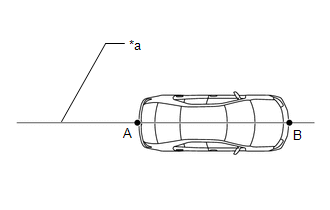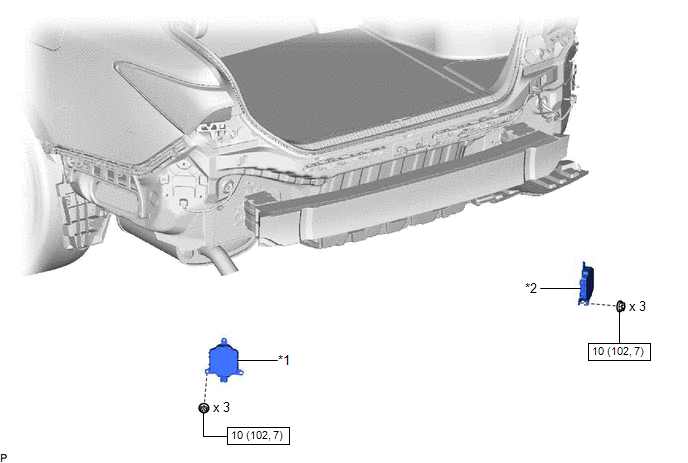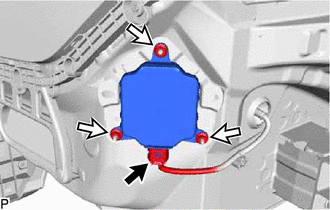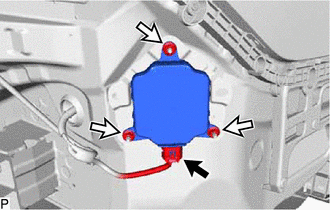Adjustment
ADJUSTMENT
PROCEDURE
1. PERFORM BLIND SPOT MONITOR BEAM AXIS CONFIRMATION
HINT:
The
blind spot monitor beam axis confirmation is performed to confirm
whether the sensor's beam axis is correct, and perform adjustment of the
beam axis by using reflector.
(a) When performing the
blind spot monitor beam axis confirmation, move the vehicle to a place
where the space shown in the illustration can be secured.
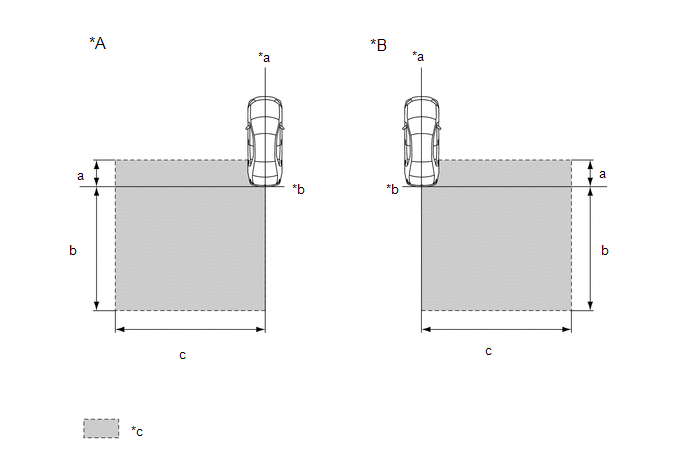
|
*A | Left Side Of Vehicle |
*B | Right Side Of Vehicle |
|
*a | Vehicle Center Line |
*b | Rear Bumper |
|
*c | Inspection Area |
- | - |
Standard:
|
Location | Measurement |
|
a | 1 m (3.28 ft.) |
|
b | 5 m (16.41 ft.) |
|
c | 6 m (19.68 ft.) |
NOTICE:
- Perform this inspection on level ground.
- Make sure that there are no metal objects around the vehicle or on the ground.
- Unload the vehicle before beginning the inspection.
- Confirm that the tire pressure is correct before beginning the inspection.
- Do not place any objects other than the reflector (such as a large
metallic object) in or allow people to enter the inspection area (W 6 m
[19.68 ft.] x L 6 m [19.68 ft.] x H 4 m [13.12 ft.]) shown in the
illustration.
(b) Place the reflector.
(1)
Hang a weight with a pointed tip from the center of the rear emblem,
and mark the rear center point of the vehicle (point A) on the ground.
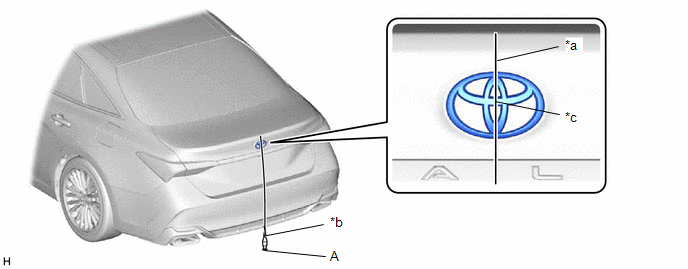
|
*a | String |
*b | Weight |
|
*c | Center |
- | - |
HINT:
Lightly flick the string with your fingers several times to confirm that the string is aligned with mark A.
(2)
Hang a weight with a pointed tip from the center of the radiator grille
(or front panel) emblem, and mark the front center point of the vehicle
(point B) on the ground.
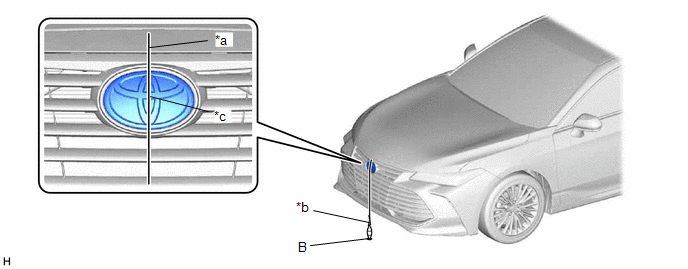
|
*a | String |
*b | Weight |
|
*c | Center |
- | - |
HINT:
Lightly flick the string with your fingers several times to confirm that the string is aligned with mark B.
| (3) Draw a vehicle center line so that it passes through mark A and B (front and rear center points). |
|
(4) Enlarge and print out the poster shown in the illustration.
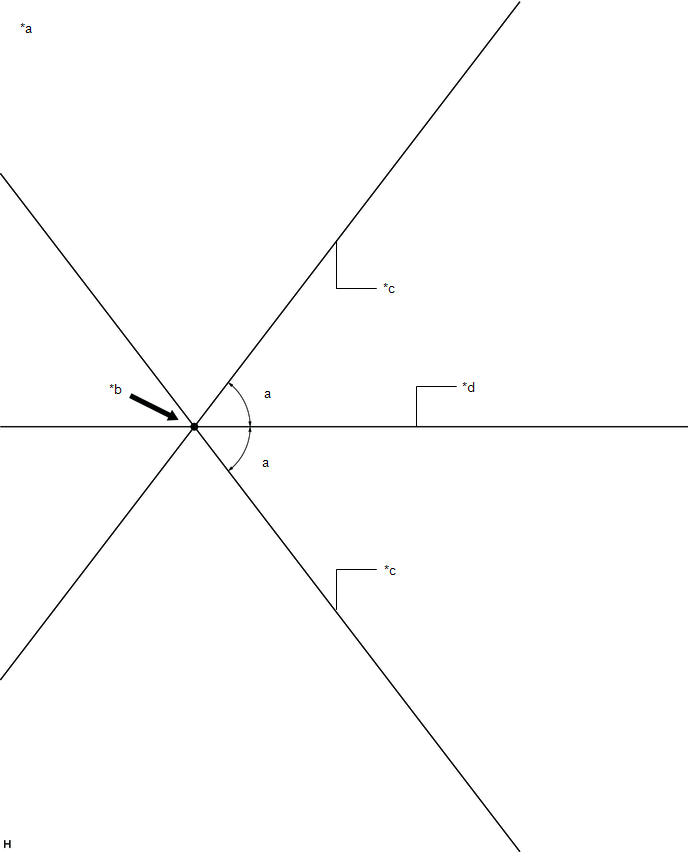
|
*a | Poster |
*b | Edge of Rear Bumper |
|
*c | Line C |
*d | Vehicle center line |
Standard:
| (5) Attach the printed poster to the floor with the vehicle center line aligned with point A as shown in the illustration. |
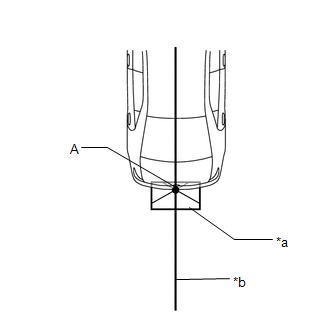 |
|
*a | Poster | |
*b | Vehicle Center Line | | |
| (6) Align a piece of string with line C and mark point D at a distance of 3373 mm (11.07 ft.) from point A. |
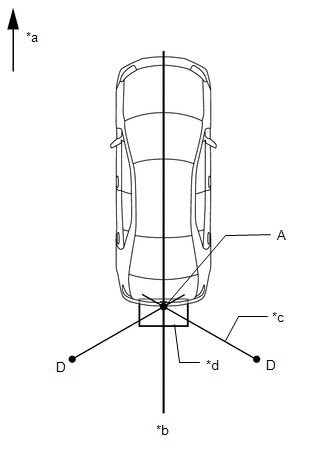 |
|
*a | Vehicle Front | |
*b | Vehicle Center Line | |
*c | String | |
*d | Poster | | |
(7) Set the reflector at the point D shown in the illustration below.
SST: 09870-60000
09870-60010
SST: 09870-60040
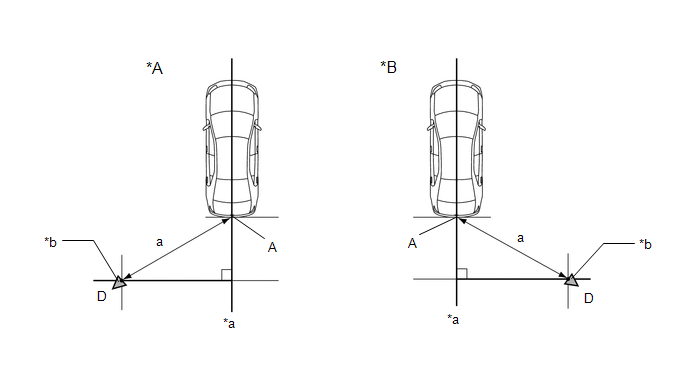
|
*A | Left Side Of Vehicle |
*B | Right Side Of Vehicle |
|
*a | Vehicle Center Line |
*b | Reflector |
Standard:
|
Part | Length |
|
a | 3373 mm (11.07 ft.) |
NOTICE:
- Set the reflector so that its center is 596 mm (1.95 ft.) above the ground.
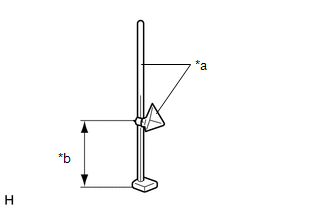
|
*a |
SST (reflector) |
|
*b |
596 mm (1.95 ft.) |
- The center of the triangular pyramid is the reference point for the setting position and angle.
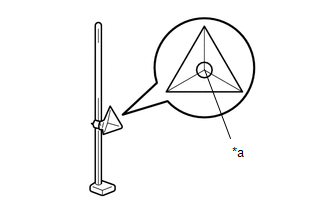
|
*a |
Center Of Triangular Pyramid |
- Set the reflector as shown in the illustration so that the center of the triangular pyramid faces the blind spot monitor sensor.
(c) Perform the blind spot monitor beam axis display.
(1) Connect the GTS to the DLC3.
(2) Turn the engine switch on (IG).
(3) Turn the blind spot monitor system on.
(4) Turn the GTS on.
(5)
Enter the following menus: Body Electrical / Blind Spot Monitor Master
or Blind Spot Monitor Slave / Utility / BSM Master Beam Axis Display or
BSM Slave Beam Axis Display.
HINT:
The master beam is on the RH side and the slave beam is on the LH side.
Body Electrical > Blind Spot Monitor Master > Utility
|
Tester Display |
| BSM Master Beam Axis Display |
Body Electrical > Blind Spot Monitor Slave > Utility
|
Tester Display |
| BSM Slave Beam Axis Display |
(6) Check the results displayed for the BSM beam axis display.
Allowable Range:
|
Item | Blind Spot Monitor Sensor RH |
Blind Spot Monitor Sensor LH |
|
Angle | -3.6 to +3.6° |
-3.6 to +3.6° |
HINT:
If
the displayed results are outside the permissible range, the following
are possible causes. Therefore, implement countermeasures, check the
blind spot monitor beam axis and perform the procedure again.
|
Possible Causes | Countermeasure |
|
Incorrect SST (reflector) position |
Check the position of SST (reflector) and checking space and perform the procedure again |
|
A metallic object is located in the vicinity of the checking space |
Check the position of SST (reflector) and checking space and perform the procedure again |
|
The blind spot monitor sensor installation is abnormal |
Check the installation condition of the blind spot monitor sensor |
(d) Perform the blind spot monitor beam axis adjustment.
(1)
Enter the following menus: Body Electrical / Blind Spot Monitor Master
or Blind Spot Monitor Slave / Utility / BSM Master Beam Axis Adjustment
or BSM Slave Beam Axis Adjustment.
Body Electrical > Blind Spot Monitor Master > Utility
|
Tester Display |
| BSM Master Beam Axis Adjustment |
Body Electrical > Blind Spot Monitor Slave > Utility
|
Tester Display |
| BSM Slave Beam Axis Adjustment |
HINT:
When
values on the axis display are in the allowable range, performing this
adjustment compensates for any deviation from the normal value.
2. PERFORM BLIND SPOT MONITOR SENSOR INSTALLATION CONDITION INSPECTION
NOTICE:
- Perform this inspection on level ground.
- Unload the vehicle before beginning the inspection.
- Confirm that the tire pressure is correct before beginning the inspection.
HINT:
The
blind spot monitor sensor installation condition inspection is performed
to confirm whether the sensor is perpendicular to the floor surface
(+/-5°) by using a jig, and that the sensor is 46 to 54° from the line
parallel to the vehicle center line.
(a) Remove the rear bumper assembly.
Click here 
(b)
Attach a jig similar to the one shown in the illustration to the
outward facing surface of the blind spot monitor sensor and check that
the measurement or angle is within the allowable range to confirm that
the blind spot monitor sensor is perpendicular to the floor surface
(+/-5°).
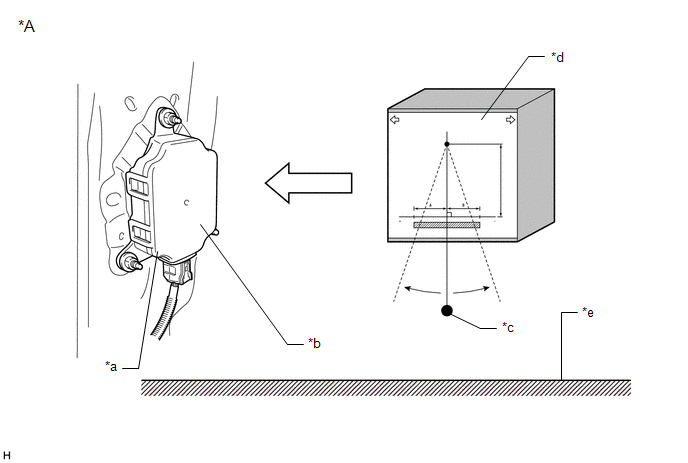
|
*A | Rear view of vehicle (RH): |
- | - |
|
*a | Blind Spot Monitor Sensor |
*b | Outward facing surface |
|
*c | Weight |
*d | Jig |
|
*e | Floor surface |
- | - |
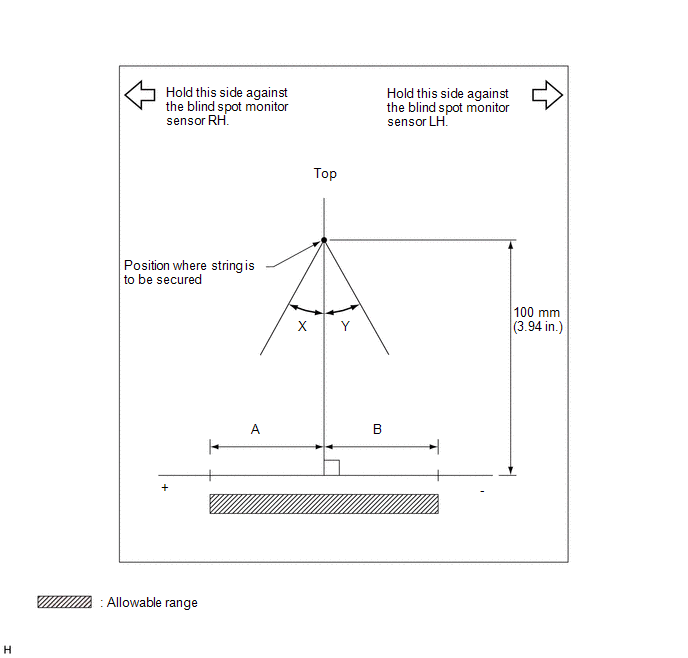
Standard:
| |
A | B |
|
Blind spot monitor sensor RH |
7 mm (0.276 in.) |
-7 mm (-0.276 in.) |
|
Blind spot monitor sensor LH |
7 mm (0.276 in.) |
-7 mm (-0.276 in.) |
| |
X | Y |
|
Blind spot monitor sensor RH |
5° | -5° |
|
Blind spot monitor sensor LH |
5° | -5° |
| (c)
Using the sensor installation stud bolt center lines as a reference,
check that the stud bolts are as shown in the illustration. Standard: |
Dimension | Specified Value | |
a | 108 mm (4.25 in.) | |
y | 78 to 87 mm
(3.07 to 3.43 in.) | |
Degree | Specified Value | |
A | 46 to 54° |
HINT: If
the results are not as specified, it is possible that the blind spot
monitor sensor installation area (frame, stud bolt) is deformed, so make
corrections as necessary. |
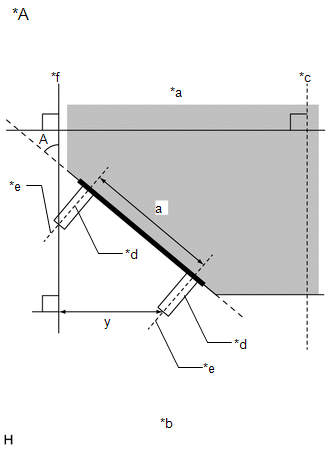 |
|
*A | Vehicle Rear (LH) | |
*a | Vehicle Front | |
*b | Vehicle Rear | |
*c | Vehicle Center Line | |
*d | Stud Bolt | |
*e | Stud Bolt Center Line | |
*f | Line Parallel To The Vehicle Center Line | | |
Installation
INSTALLATION
CAUTION / NOTICE / HINT
NOTICE:
- Avoid any impact to the blind spot monitor sensor.
- Do not drop the blind spot monitor sensor. If it is dropped, replace it with a new one.
HINT:
- The blind spot monitor beam axis confirmation is performed to confirm
whether the sensor beam axis is correct, and to adjust the beam axis by
using a reflector.
- The blind spot monitor sensor installation condition inspection is
performed to confirm whether the sensor is perpendicular to the floor
surface (+/-5°) by using a jig, and that the sensor is 46 to 54° from
the line parallel to the vehicle center line.
PROCEDURE
1. INSTALL BLIND SPOT MONITOR SENSOR LH
(a) Connect the connector.
(b) Install the blind spot monitor sensor LH with the 3 nuts.
Torque:
10 N·m {102 kgf·cm, 7 ft·lbf}
2. INSTALL BLIND SPOT MONITOR SENSOR RH
(a) Connect the connector.
(b) Install the blind spot monitor sensor RH with the 3 nuts.
Torque:
10 N·m {102 kgf·cm, 7 ft·lbf}
3. PERFORM BLIND SPOT MONITOR SENSOR INSTALLATION CONDITION INSPECTION
Click here 
4. INSTALL REAR BUMPER ASSEMBLY
Click here 
5. PERFORM BLIND SPOT MONITOR BEAM AXIS CONFIRMATION
Click here 
6. PERFORM DIAGNOSTIC SYSTEM CHECK
for Gasoline Model: Click here 
for HV Model: Click here

Removal
REMOVAL
CAUTION / NOTICE / HINT
The
necessary procedures (adjustment, calibration, initialization, or
registration) that must be performed after parts are removed and
installed, or replaced during blind spot monitor sensor
removal/installation are shown below.
Necessary Procedure After Parts Removed/Installed/Replaced (for Gasoline Model) |
Replaced Part or Performed Procedure |
Necessary Procedure | Effect/Inoperative Function When Necessary Procedures are not Performed |
Link |
| Blind spot monitor sensor |
Blind spot monitor beam axis adjustment |
- Intelligent Clearance Sonar System
- Blind Spot Monitor System
|
 |
|
Rear bumper assembly |
- Measure ultrasonic sensor detection angle
- Ultrasonic sensor detection angle registration
|
- Intelligent Clearance Sonar System
- Intuitive Parking Assist System
|
 |
Necessary Procedure After Parts Removed/Installed/Replaced (for HV Model) |
Replaced Part or Performed Procedure |
Necessary Procedure | Effect/Inoperative Function When Necessary Procedures are not Performed |
Link |
| Blind spot monitor sensor |
Blind spot monitor beam axis adjustment |
- Intelligent Clearance Sonar System
- Blind Spot Monitor System
|
 |
|
Rear bumper assembly |
- Measure ultrasonic sensor detection angle
- Ultrasonic sensor detection angle registration
|
- Intelligent Clearance Sonar System
- Intuitive Parking Assist System
|
 |
PROCEDURE
1. REMOVE REAR BUMPER ASSEMBLY
Click here

2. REMOVE BLIND SPOT MONITOR SENSOR LH
| (a) Disconnect the connector. | |
(b) Remove the 3 nuts and blind spot monitor sensor LH.
NOTICE:
Replace the blind spot monitor sensor LH if it has been dropped or subjected to a severe impact.
3. REMOVE BLIND SPOT MONITOR SENSOR RH
| (a) Disconnect the connector. | |
(b) Remove the 3 nuts and blind spot monitor sensor RH.
NOTICE:
Replace the blind spot monitor sensor RH if it has been dropped or subjected to a severe impact.



